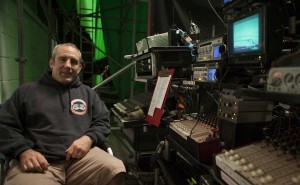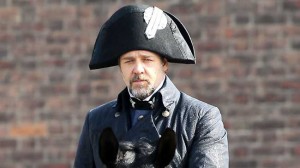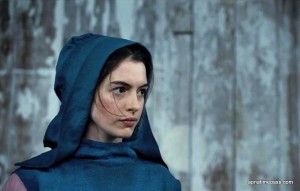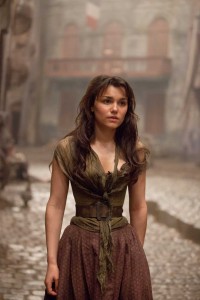
The buzz around town reported by some press has been that the singing in Les Misérables was unique because it was recorded live, something that had never been done before in a movie musical. Production sound mixer Simon Hayes wants to set the record straight. “That’s not what we’re claiming, and we never did claim it was the first time,” said Hayes. “Where Les Mis the movie is unique, and I think is groundbreaking and we are indeed the first, isn’t just the live singing element. What was really exciting about director Tom Hooper’s vision was that he didn’t want to tie the actor’s performances to a prerecorded track.”
Instead of the usual prerecorded orchestrations that the actors would follow, the music was played by a live pianist, who knew the score intimately, located in a sound proof room on set, watching the performance on a monitor. The pianist had explicit instructions to follow the actor. This allowed the acting to take precedence. The actor – listening to the music through hidden earplugs – could speed up or slow down any passage, or even pause to emphasize a moment (just like a fermata). Although it was very time-consuming to get the vocal right on set, this method created a visceral raw effect and a much more emotive performance.
 Another benefit came from recording live while using the actors’ performances as the basis for the rhythm. When an actor is following a pre-recorded track, the lip sync slips. This method of live vocal recording made it possible for the camera to go in really tight and hold on a shot because the sync was real. Even imperfections in the voice from the live recording served to add to the power of the performances.
Another benefit came from recording live while using the actors’ performances as the basis for the rhythm. When an actor is following a pre-recorded track, the lip sync slips. This method of live vocal recording made it possible for the camera to go in really tight and hold on a shot because the sync was real. Even imperfections in the voice from the live recording served to add to the power of the performances.
Orchestrations were matched to the vocals. Hayes comments, “That obviously presented huge difficulties in postproduction when the score was finally recorded. If you listened to a piece of the music on it’s own, you’d say. ‘The tempo is shifting, it’s unacceptable!’ However, what we found – and this is exciting – was that you would gain so much in the connection between the audience and the performers, and you don’t even notice the wavering in the tempo.”
 The live singing presented other issues that could only be solved through the concerted collaboration of numerous departments. Hooper gathered the department heads together to discuss the problem. The director made it clear that there would be no re-recording of the vocals in post. Since any sound recorded during a scene would be tied to the singing, departments including camera, production design and special effects, all had to take into account the effect of their work on the sound. This produced unprecedented cooperation on set.
The live singing presented other issues that could only be solved through the concerted collaboration of numerous departments. Hooper gathered the department heads together to discuss the problem. The director made it clear that there would be no re-recording of the vocals in post. Since any sound recorded during a scene would be tied to the singing, departments including camera, production design and special effects, all had to take into account the effect of their work on the sound. This produced unprecedented cooperation on set.
After the meeting, Eve Stewart, the production designer, asked Hayes what she could do to help the sound recording. “I told her, the problems we are going to have on the set, are that we are going to have footsteps underneath the singing that we can’t remove from the singing, and doors closing and other people walking, and so on,” explained Hayes. “What we need, is for everything to be real, so it sounds real. So the cobblestones on the street, were real cobblestones. If a door looks like it is made of oak, it is, so it sounds like that.” Consequently the production design was more involved that normal.
 Many sequences shot on an interior set were supposed to be outside, so they required a source of wind. The special effects department had to find a new way to create wind. Normally a fan would be used, but fan noise has a frequency that is impossible to remove from vocals. To solve the problem, the effects team designed special fans that were put outside the stage. Holes were drilled in the walls and the air was piped in through air conditioning ducts. A special effects technician pointed the duct at the actor. This method limited the wind noise to a high-pitch that was much easier to remove during the final mix.
Many sequences shot on an interior set were supposed to be outside, so they required a source of wind. The special effects department had to find a new way to create wind. Normally a fan would be used, but fan noise has a frequency that is impossible to remove from vocals. To solve the problem, the effects team designed special fans that were put outside the stage. Holes were drilled in the walls and the air was piped in through air conditioning ducts. A special effects technician pointed the duct at the actor. This method limited the wind noise to a high-pitch that was much easier to remove during the final mix.
Another big problem was the rain, used in several scenes. Working with director of photography Danny Cohen, the team experimented with rain. The droplets were turned into a spray, made finer and finer up to the point where it could not be seen. Then the flow was restored a bit so that it could still be seen while keeping it as quiet, as possible. In addition, every surface that was not in the shot was covered with synthetic horsehair to absorb the water while muffling the sound.
According to Hayes, “We approached every single scene with this level of attention to detail, as a team in complete collaboration.” In this way the vocal performances achieved an emotional resonance unique among musicals.





